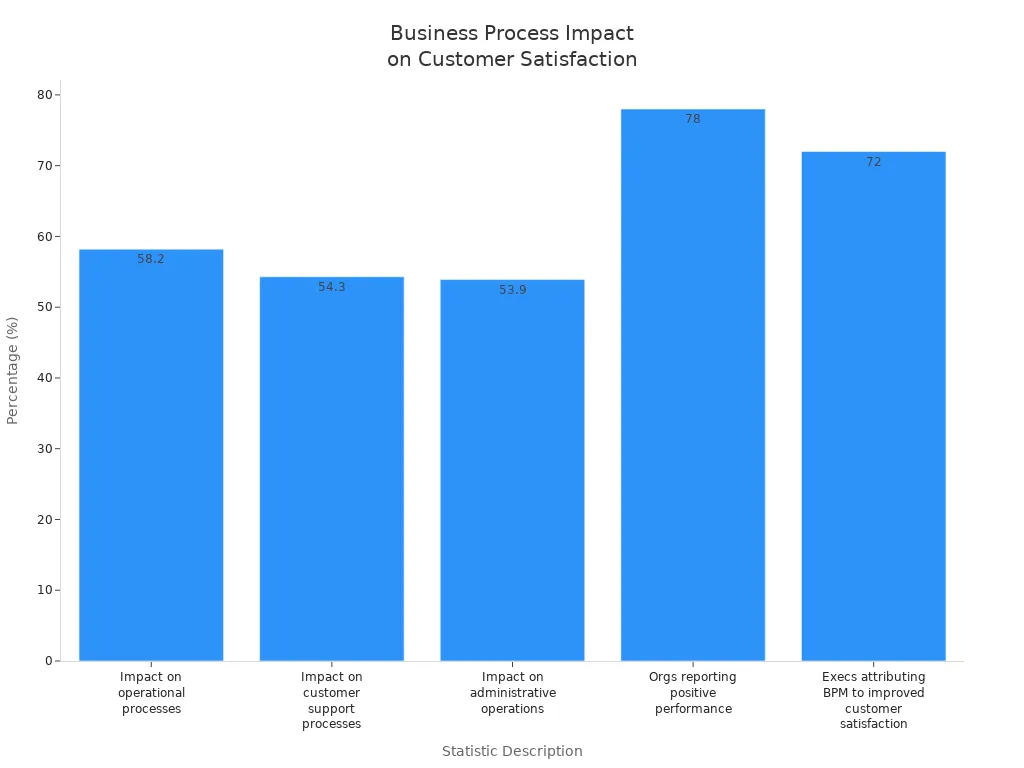3 Easy Ways Business Process Operations Help You Grow

Business Process Operations deliver growth by streamlining workflows, raising consistency and quality, and supporting scalability. Companies often face operational inefficiencies, high implementation costs, inadequate planning, resistance to change, and integration issues with existing systems. By applying targeted Optimization Steps, organizations can improve each Process and enhance outcomes for customers. This approach helps teams overcome common barriers and build a foundation for sustainable success.
Key Takeaways
Business Process Operations streamline workflows, leading to increased efficiency and productivity.
Identifying bottlenecks and inefficiencies is crucial for improving overall process performance.
Automation tools can significantly reduce manual work, allowing teams to focus on more important tasks.
Standardizing processes through documentation and checklists enhances consistency and quality in service delivery.
Setting clear goals and tracking key performance indicators (KPIs) helps measure the success of process improvements.
Flexible systems enable businesses to adapt quickly to changes and support scalability as they grow.
Effective communication and team involvement are essential for successful change management during process improvements.
Investing in expert guidance can accelerate progress and help avoid common pitfalls in process optimization.
Business Process Operations Overview
What It Means
Business Process Operations describe the structured approach organizations use to manage and improve their daily activities. These operations include the analysis, design, execution, and monitoring of business processes. Each process follows a clear path from start to finish, ensuring that tasks move smoothly and efficiently.
Key Elements
A well-designed process contains several important components. The table below outlines these key elements and their roles:
Key Component | Description |
|---|---|
Process objective | A statement describing the specific goal or objective the process is designed to achieve. |
Inputs | Data, information, materials, and resources needed to initiate and execute the process. |
Activities/Tasks | Specific actions or operations performed to achieve the process objective. |
Resources | People, tools, technologies, and facilities needed to carry out the activities. |
Outputs | End results or products generated from carrying out the process. |
Responsibilities | Definition of who is responsible for each activity or task, including roles and departments. |
Controls | Mechanisms to monitor and refine the process to meet standards and objectives. |
Timeline | Schedule outlining when each activity should begin and end, including milestones. |
These elements help organizations create clear and repeatable steps for every important activity.
Main Goals
Business Process Operations aim to:
Increase efficiency by reducing wasted time and resources.
Improve quality and consistency in products and services.
Support organizational goals by aligning daily activities with strategic objectives.
Enable quick problem detection and resolution.
Why It Matters
Operational processes deliver value to both customers and the organization. When a company manages its processes well, it can:
Evidence Description | Contribution to Value Delivery |
|---|---|
Core business processes streamline workflows | Increases efficiency and productivity |
Directly enhances customer satisfaction | |
Alignment of strategy with operations | Ensures that activities support organizational goals |
Processing customer orders enhances customer satisfaction.
Managing service delivery improves operational efficiency.
Product manufacturing contributes to the value chain.
Timely recognition and resolution of problems play a critical role in Business Process Operations. For example, in a food processing plant, manufacturing dashboards allow managers to monitor production lines in real time. This visibility helps them spot bottlenecks early, leading to better decisions and improved performance.
Identifying and addressing bottlenecks can lead to significant improvements in overall process performance.
Once improvements are implemented, it is crucial to measure and monitor their impact through tracking relevant KPIs and conducting regular reviews.
Note: Effective Business Process Operations help organizations stay competitive by delivering consistent value and adapting quickly to changes.
Streamlining Workflows

Streamlining workflows stands as a core benefit of Business Process Operations. Companies that focus on workflow improvement often see faster results, better use of resources, and fewer errors. This section explores how organizations can identify issues and improve efficiency using proven tools and strategies.
Identifying Issues
Bottlenecks
Bottlenecks slow down progress and create frustration for teams. They often appear when one step in a process takes longer than others or when approvals pile up. Managers can spot bottlenecks by tracking how long each task takes and where work gets stuck. For example, a dashboard that shows overdue tasks helps teams see which steps need attention.
Inefficiencies
Inefficiencies waste time and money. These can include duplicate data entry, unclear instructions, or manual steps that could be automated. Teams should review each process step and ask if it adds value. Removing unnecessary actions can make a big difference in daily operations.
Improving Efficiency
Automation
Automation tools help companies complete tasks faster and with fewer mistakes. Many businesses use workflow analysis and automation platforms to streamline operations. Some of the most effective tools include:
Nintex: Manages and optimizes workflows across systems.
Kissflow: Customizable cloud-based workflows and reports.
Trello: Visualizes workflows with boards and cards.
Asana: Plans and manages workflows efficiently.
Wrike: Collaborative work management with automation.
Zapier: Connects apps to automate workflows.
Flow (Power Automate): Automates tasks across applications.
Airtable: Builds custom workflows and automates tasks.
Smartsheet: Combines spreadsheets with automation features.
These tools help teams reduce manual work and focus on more important tasks.
Resource Use
Better resource use means assigning the right people and tools to each job. When companies streamline workflows, they often see measurable improvements:
Improvement Type | Description |
|---|---|
Employees complete tasks more efficiently, leading to increased output without additional resources. | |
Cost Efficiency | Reduces operational expenses by eliminating unnecessary steps, allowing savings to be reinvested. |
Optimized Resource Allocation | Focuses on value-adding activities, maximizing the impact of efforts and enhancing ROI. |
Better Compliance & Risk Management | Improves audit readiness and minimizes risks of non-compliance penalties through structured processes. |
Teams also report benefits such as improved operational efficiency, reduced costs, increased agility, fewer errors, and better data-driven decisions.
Tip: Start with small changes for quick wins. For example, Network IT Easy automated report collection and saved over 300 hours per month. Geekbox IT used real-time ticket alerts to improve response times and security. Marcus Networking automated user onboarding, which increased accuracy and reduced risk.
Quick wins like these show that even simple changes can have a big impact on workflow performance.
Consistency And Quality
Consistency and quality form the backbone of reliable business operations. When companies standardize their processes, they create a strong foundation for delivering dependable results. Customers notice when a business provides the same high level of service every time. This builds trust and encourages repeat business.
Standardizing Processes
Documentation
Clear documentation helps teams understand each step in a process. Written guides, flowcharts, and instructions make it easier for employees to follow best practices. When everyone uses the same instructions, mistakes become less common. Documentation also helps new team members learn quickly and reduces confusion during busy times.
Checklists
Checklists ensure that important steps never get missed. Employees can use checklists to track their progress and confirm that they have completed every task. This simple tool supports accuracy and helps teams deliver consistent results, even when handling complex projects.
Companies that use documentation and checklists often see fewer errors and faster onboarding for new staff.
Research shows that standardization plays a key role in building customer trust. The table below highlights how process standardization supports customer satisfaction and reliability:
Evidence | Description |
|---|---|
Standardization and Customer Satisfaction | The study confirms that standardization of processes leads to improved customer satisfaction, which is essential for fostering customer trust. |
Operational Reliability | Standardization reduces complexity and minimizes errors, ensuring services meet customer expectations, thereby enhancing trust. |
Consistent Service Quality | Establishing consistent service quality through standardization is crucial for building customer trust in service providers. |
Reliable Results
Training
Ongoing training ensures that employees understand the latest procedures and quality standards. Well-trained staff can spot potential problems early and take action to prevent them. Training also helps teams adapt to new tools or updated processes, keeping quality high as the business grows.
Metrics
Companies use specific metrics to measure quality and reliability. These metrics help leaders track performance and identify areas for improvement. Common metrics include:
Metric | Description |
|---|---|
Quality | The output (service or product) meets the client standards, internal QA and budget. |
Error rate | The number of units, products or service that failed during the entire process cycle. |
Customer satisfaction | How well the process meets the customer’s expectations. |
Process efficiency | Measures the allocation and utilization of resources, employee skills, and delay times. |
Process cycle time | Measures how long it takes to complete a given task, revealing inefficiencies in the process flow. |
Tracking these metrics helps businesses maintain high standards and respond quickly to any issues.
Real-world examples show the power of standardization. For instance:
Company | Standardization Method | Outcome |
|---|---|---|
McDonald's | Lean principles | Improved kitchen operations and supply chain efficiency, reducing food waste and improving order accuracy. |
Walmart | Six Sigma | Enhanced supply chain visibility, reducing overstocking and stockouts, maintaining competitive pricing. |
McDonald's improved service quality and reduced waste by adopting Lean principles. Walmart used Six Sigma to make its supply chain more efficient, which led to better product availability for customers.
Business Process Operations rely on these strategies to deliver consistent, high-quality results that customers can trust.
Scalability And Adaptability

Growth brings new opportunities and challenges. Organizations that want to expand must build systems that support both scalability and adaptability. Well-structured processes help businesses handle more customers, enter new markets, and respond to changes without losing quality or efficiency.
Preparing For Growth
Flexible Systems
Flexible systems allow companies to adjust quickly as they grow. These systems make it easier to add new products, serve more customers, or open new locations. When processes remain clear and adaptable, teams can handle increased workloads without confusion or delays. Many industry reports highlight the benefits of strong business processes for scalability:
Benefit | Description |
|---|---|
Enhanced Efficiency | Strong business processes boost operational efficiency, especially in competitive environments. |
Reduced Errors | A structured approach minimizes mistakes, leading to better outcomes. |
Facilitated Adaptability | Well-defined processes allow organizations to adapt quickly to changes in the market. |
Scalable businesses often save money through improved efficiency. They can increase revenue by serving more customers and finding new ways to grow. Customers also benefit from faster service and better experiences.
Control
Maintaining control during growth prevents chaos. Clear roles, responsibilities, and controls help teams stay organized. Leaders use regular reviews and performance checks to ensure everyone follows the right steps. This structure reduces errors and keeps quality high, even as the business expands.
Adapting To Change
Updates
Markets change quickly. Companies must update their processes to stay competitive. Adaptable organizations foster leadership at all levels and use flexible management approaches. Scenario planning helps teams prepare for different market situations. Many businesses use new technologies, such as AI-enabled automation and analytics, to improve efficiency and reduce costs.
Evidence | Description |
|---|---|
Helps organizations perform mechanical tasks efficiently. | |
AI-enabled analytics capability | Allows processing of information and completion of analytics tasks. |
AI-enabled relational capability | Facilitates direct interaction with humans, enhancing responsiveness. |
Staying ahead of industry trends gives companies a competitive edge. Aligning with consumer preferences also increases customer satisfaction and loyalty.
Feedback
Feedback plays a key role in adaptability. Teams gather input from customers and employees to spot areas for improvement. Open communication helps organizations respond to problems quickly and adjust their strategies. Regular feedback ensures that processes remain effective as the business environment changes.
Many businesses face challenges when scaling. Common issues include team burnout, lack of clear vision, poor communication, outdated processes, losing focus, and managing cash flow. Successful organizations overcome these challenges by:
Building a solid foundation before expanding.
Setting clear goals and key performance indicators.
Promoting open, two-way communication.
Regularly updating processes and investing in technology.
Monitoring cash flow and maintaining financial forecasts.
Tip: Companies that invest in flexible systems and regular updates can adapt faster and grow more smoothly.
Business Process Operations provide the structure needed for both scalability and adaptability. With the right processes in place, organizations can expand confidently and respond to change with agility.
Overcoming Challenges
Business process operations often face two main challenges: managing change and controlling costs. Addressing these challenges helps organizations achieve smoother transitions and better financial outcomes.
Change Management
Change can create uncertainty for teams. Employees may worry about new systems or fear losing control over their work. Leaders who understand these concerns can guide their teams through transitions more effectively.
Communication
Clear communication stands at the heart of successful change management. Leaders should explain the reasons for change, the expected benefits, and how the changes will affect daily tasks. Open conversations help reduce confusion and build trust. When employees know what to expect, they feel more confident and engaged.
Team Involvement
Involving team members in the change process increases buy-in and commitment. Employees who participate in planning and decision-making often feel a sense of ownership. Training and support also play a key role. When organizations provide resources and address concerns directly, teams adapt more quickly.
The table below highlights effective strategies for managing resistance to change:
Strategy | Description |
|---|---|
Communication | Clearly communicate the reasons for the change, benefits, and impact on employees’ work. |
Participation | Encourage employee involvement in the change process to build ownership and commitment. |
Support | Provide adequate training and support to help employees adapt to the change and develop new skills. |
Addressing Concerns | Address employee concerns and fears directly and provide reassurance and support. |
Celebrating Successes | Celebrate successes and progress to build momentum and reinforce positive behaviors. |
Leading by Example | Leaders should model the behavior they expect from employees and demonstrate a positive attitude towards change. |
Tip: Celebrating small wins during transitions can boost morale and reinforce positive behaviors.
Cost Management
Cost management ensures that process improvements deliver value without overspending. Organizations that plan carefully and monitor expenses can achieve better results.
Budget Solutions
Successful cost management starts with clear planning. Leaders set budgets, monitor spending, and look for ways to reduce unnecessary expenses. Common techniques include:
Cost reduction
Cost control
Cost planning
Cost optimization strategies
Many organizations also use workforce analytics, improve procurement processes, and invest in automation to manage costs more effectively.
ROI
Measuring return on investment (ROI) helps organizations understand the impact of process improvements. Companies that track ROI can see which changes deliver the most value. For example, Toyota used Lean Manufacturing to achieve a 15:1 ROI, reducing inventory costs by 30% and boosting efficiency. General Electric saved $12 billion over five years with Six Sigma, achieving a tenfold return. Amazon’s process automation paid for itself within two years, cutting labor costs by 20% and increasing order accuracy.
Company | Process Improvement Type | ROI | Results |
|---|---|---|---|
Toyota | Lean Manufacturing | 15:1 | Reduced inventory costs by 30% and increased overall efficiency. |
General Electric | Six Sigma | 10x | Saved approximately $12 billion over five years and improved defect rates. |
Amazon | Process Automation | Paid for itself within 2 years | Reduced labor costs by 20% and increased order accuracy and processing speed. |
Organizations that focus on both change management and cost control can overcome common barriers and achieve lasting growth.
Success Stories
Small Business Wins
Transformation
Many small businesses have seen real change after improving their business process operations. Leaders at systems and teams have guided clients through these changes, helping them move from disorganized workflows to clear, repeatable processes. Some notable examples include:
Nicole Carter, CEO of Creative Flame Media, used templates to bring order to her business. She reported that this shift improved profitability and reduced chaos.
Essie Escobedo from Office Angels documented and defined her business infrastructure. This step prepared her company for future growth.
Louisa Kamau at STAFFING worked with Equilibria to develop a system that increased efficiency. She gained a blueprint for expansion.
Brett Manning in real estate processed more loans after working with Equilibria, which contributed to business growth.
Gwen Keyes-Fleming in municipal government improved public responsiveness and streamlined operations.
These stories show that clear systems and strong teams can drive business growth. Each client at systems and teams focused on building a foundation that supports both daily work and long-term goals.
Lessons
Small businesses have learned important lessons from these transformations. They discovered that understanding current workflows is the first step. Defining clear process goals comes next. Selecting the right tools and fostering a culture of continuous improvement also matter.
A practical approach often includes:
Understand your current workflow.
Define your process goals.
Explore targeted tools.
Compare features that solve real issues.
Test in a real setting.
Ask for team input.
Implement gradually and support change.
Track performance and adjust.
Organizations that follow these steps see lower costs, higher customer satisfaction, better employee engagement, and stronger brand reputation.
Industry Examples
Retail
Retailers have used business process operations to improve customer experience. Automation of returns processing makes returns quick and efficient. This change is especially important as online shopping grows. Data-driven insights help retailers spot customer trends. They can then adjust pricing and stock levels to maximize sales.
Services
Service-based companies also benefit from process improvements. Business process automation (BPA) enhances efficiency in HR, finance, and quality control. Teams at systems and teams have helped clients apply BPA across departments, not just in traditional areas. This approach leads to faster, more consistent, and transparent operations.
Business process automation saves time and reduces errors. It aligns daily work with company policies and supports growth in any industry.
Key Insights | Description |
|---|---|
Successful BPO Strategies | Analyze what works to find best practices for positive results. |
Lessons from Failures | Learn from mistakes to avoid common risks. |
These stories and tips show that strong systems and teams, paired with the right tools, help businesses grow and adapt in any industry.
Getting Started
First Steps
Assessment
Small businesses often begin by assessing their current processes. Leaders identify which tasks need standard operating procedures (SOPs). They collect materials for documentation and focus on processes with multiple steps or frequent errors. This assessment helps teams understand where improvements will have the most impact.
A simple checklist can guide this stage:
Identify essential tasks that need SOPs.
Gather existing materials and instructions.
Highlight processes that often cause mistakes or delays.
Tip: Teams that involve employees in this assessment often discover hidden bottlenecks and valuable insights.
Goal Setting
Setting clear goals gives direction to process improvements. Most businesses aim to increase revenue, reduce costs, or improve relationships with customers and employees. Leaders define what they want to achieve and discuss these goals with stakeholders. Mapping out the workflow, including resources and responsibilities, creates a strong foundation.
A typical goal-setting process includes:
Plan improvements with input from all team members.
Map the workflow, assigning roles and listing needed tools.
Clear goals help teams measure progress and stay focused on results.
Resources
Templates
Templates play a key role in business process operations. They provide a proven structure, much like a recipe guides a chef. Employees who follow templates complete tasks more efficiently and with fewer errors. Templates also make training easier and support a strong learning culture. According to recent reports, organizations with accessible documentation and templates see higher employee retention and better onboarding experiences.
Templates also improve transparency. They clarify roles and responsibilities, making it easier for managers to track progress and for teams to understand expectations. Many resources offer ready-to-use templates, such as:
The Complete Guide to Process Documentation and Process Improvement
Performance Improvement Plan Templates
Indeed’s Performance Improvement Plan Template
Betterteam’s Performance Improvement Plan Template
Using templates helps businesses maintain consistency and accountability as they grow.
Expert Help
Some businesses benefit from expert guidance when starting process improvements. Experts can help select the right tools, update documentation, and train teams on new systems. Process documentation tools keep everyone informed about changes and ensure alignment across the organization.
Common challenges, such as inefficient workflows or technology integration, often require outside support. Experts help businesses audit current workflows, simplify processes, and plan technology adoption. They also provide training to help teams adapt to new systems.
Challenge | Description | Potential Solutions |
|---|---|---|
Outdated or complex workflows slow productivity. | Audit workflows, automate tasks, involve employees, document best practices. | |
Talent acquisition and retention | Difficulty finding and keeping skilled workers. | Strengthen employer brand, offer competitive benefits, engage employees, cross-train teams. |
Technology integration | Integrating new tools with old systems can be difficult. | Create a clear roadmap, focus on seamless integration, invest in training, strengthen cybersecurity. |
Many small businesses find that expert advice accelerates their progress and helps avoid common pitfalls.
Ready to take the next step? Reach out to learn how systems and teams can help your business achieve similar results and build a foundation for growth.
Business Process Operations drive growth by improving efficiency, ensuring consistency and quality, and enabling scalability. Companies that optimize processes see clear benefits:
Description | |
|---|---|
Identifying Inefficiencies | Recognizing delays or errors leads to improvement. |
Implementing Strategies | Redesigning and automating tasks boosts productivity. |
Measuring Performance | Tracking KPIs highlights progress and areas to improve. |
Signs of Success | Efficiency, customer satisfaction, and cost savings show strong results. |

Start optimizing today. Clear goals, strong teamwork, and simple steps can help any business achieve lasting growth.
FAQ
What are business process operations?
Business process operations refer to the steps and systems a company uses to manage daily tasks. These operations help teams work efficiently, maintain quality, and support business goals.
How do business process operations improve efficiency?
Teams use business process operations to identify slow steps and remove waste. Automation tools and clear workflows help employees complete tasks faster and with fewer mistakes.
Why is consistency important in business processes?
Consistency ensures customers receive the same quality every time. Standardized processes help teams avoid errors and deliver reliable results, which builds trust and loyalty.
Can small businesses benefit from process operations?
Small businesses gain many advantages from process operations. They can reduce costs, improve customer service, and prepare for growth by organizing tasks and using templates.
What tools help automate business processes?
Popular tools include ProcessMaker, Nintex, Kissflow, and Zapier. These platforms help companies automate tasks, track progress, and improve communication between teams.
How do companies measure process improvement success?
Companies track key performance indicators (KPIs) such as error rates, customer satisfaction, and process cycle times. Regular reviews help leaders see progress and find areas for improvement.
What challenges do businesses face when changing processes?
Teams often struggle with resistance to change, unclear communication, and cost concerns. Leaders address these issues by involving employees, providing training, and setting clear goals.
Where can businesses find resources for process improvement?
Businesses can use online templates, guides, and expert advice. Many websites offer free tools and checklists to help teams document processes and train employees.



